Summary of the Vietnam-Germany Hydrogen Workshop on 1.8.2024
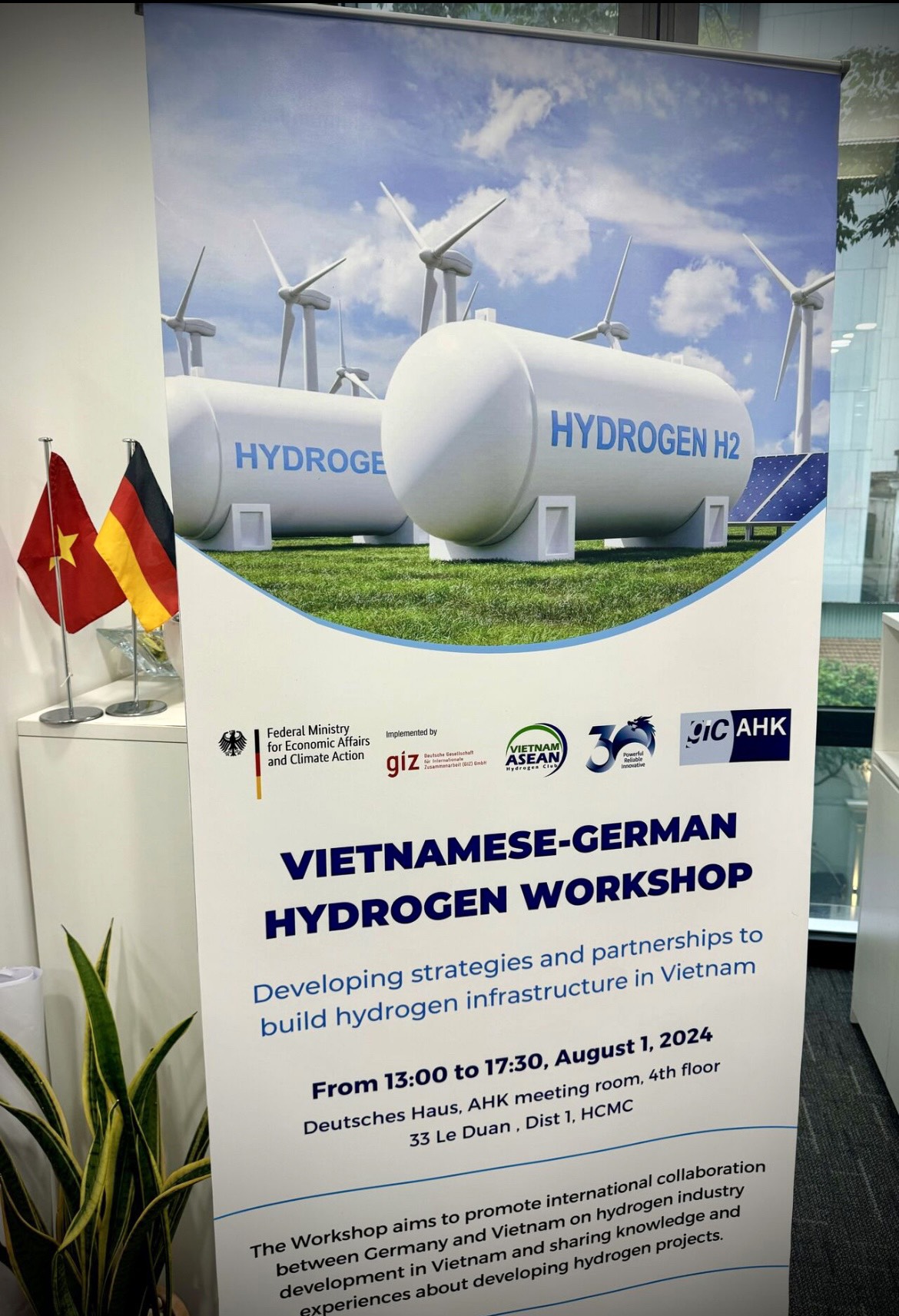
VAHC would like to express our sincere thanks to the German Agency for International Cooperation (GIZ) and the German Chamber of Commerce and Industry (AHK) for supporting and co-organizing the Vietnam-Germany Hydrogen Workshop at the AHK Office, 4th floor, Deustches Haus, 33 Le Duan, District 1, Ho Chi Minh City on 1.8.2024. Below is the summary of our Workshop. VAHC would like to sincerely thank the delegates from VAHC, GIZ, AHK, Pacific Group, Neuman & Esser, TUV, thyssenkrup, PV Gas, PVN, Ca Mau Fertilizer, Phu My Fertilizer, The Green Solutions, Standard Charters Vietnam, H&M Vietnam, Trung Nam Group, Institute for Digital Economic Development Strategy (IDS), PwC, Enertrag, Indefol, CEEC, AES Vietnam, PM3 Specialized Industrial Park, VATEC, PECC3, Siemens, Bosch, Vietnam-Germany University, VES Lawyers and other delegates.Sincere thanks to the group of interns from Van Lang University for their effective logistical support including Lam Van Loi, Bui Huong Ly and Duong Hong Quan.
About the purpose of the Workshop
Hydrogen plays an important role in overcoming the climate crisis. An integrated view of the interdependent components of the hydrogen value chain is of key importance for success worldwide.
Decarbonizing the economy to achieve climate neutrality is one of the greatest challenges facing humanity in the coming decades. This can be achieved by switching to renewable energy and linking the energy, industry, building and transport sectors. Since electricity production from renewable energy sources such as wind and solar is inconsistent, there is a need for reliable and cost-effective storage and transport options for large amounts of energy. Large-scale decarbonization can only be successful if these basic requirements are met. Hydrogen (H2) provides these capabilities in a near-ideal way and can also be used as a base material or reaction partner in the process industry.
Vietnam has a large solar and wind capacity and therefore has ideal conditions for the production of green hydrogen. During this workshop, strategies for developing hydrogen infrastructure in Vietnam will be developed. The aim is to form partnerships for hydrogen projects in Vietnam.
About the Workshop
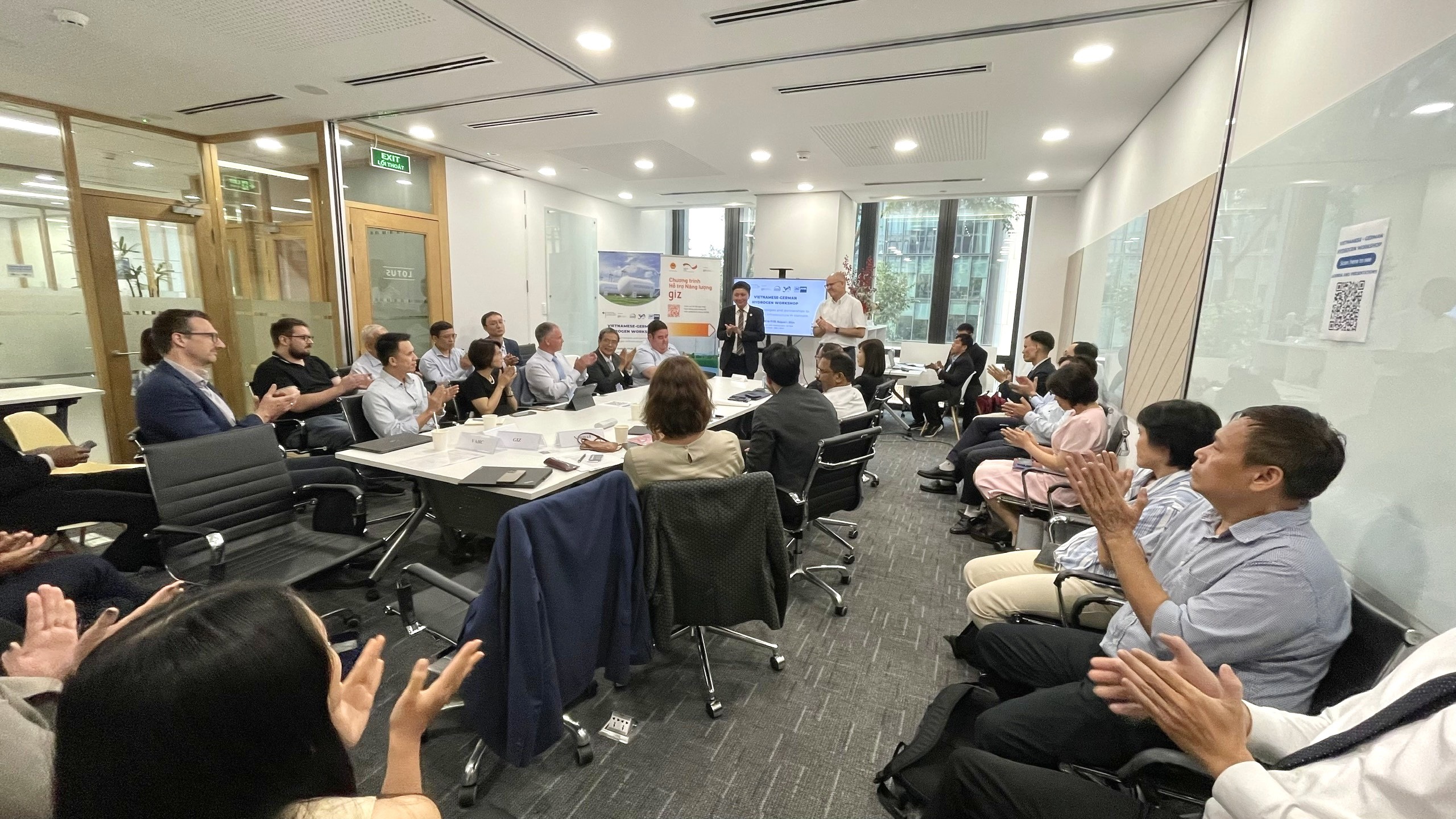
After the welcome speeches by Mr. Le Ngoc Anh Minh, Chairman of VAHC, Mr. Markus Bissel, Head of Energy Group of GIZ Vietnam and Mr. Peter Compalla, Chief Representative of the German Chamber of Commerce and Industry in Vietnam (AHK), the Workshop began with the presentation by Ms. Stefanie Peters, Member of the German National Hydrogen Council. Ms. Stefanie said that so far, 131 countries in the world have declared net-zero targets, 46 countries have conducted CO2 emission monitoring and billing, and 40 countries have announced hydrogen strategies. Hydrogen is a convenient energy carrier for storing renewable energy and ensuring energy security when countries switch to renewable energy. Hydrogen is used flexibly for many different industries, especially for large emission industries such as steel production, hydrogen is the most cost-effective. To date, more than 1,400 projects worldwide and 570 billion USD in investment have been announced. Although the published numbers are quite large, only 7% of the projects have been implemented. According to the German National Hydrogen Council, there are 8 important criteria for the formation of the hydrogen economy in the Federal Republic of Germany, and many of them are political (3 industrial criteria include developing high-efficiency electrolyzers, developing synchronous infrastructure for pioneering projects and ensuring changes in social security, and 5 political factors include tax reform policies, creating friendly financial instruments, creating conditions for investment in environmentally friendly technologies, establishing a common technical legal framework for Europe, and expanding renewable energy in Germany and Europe).
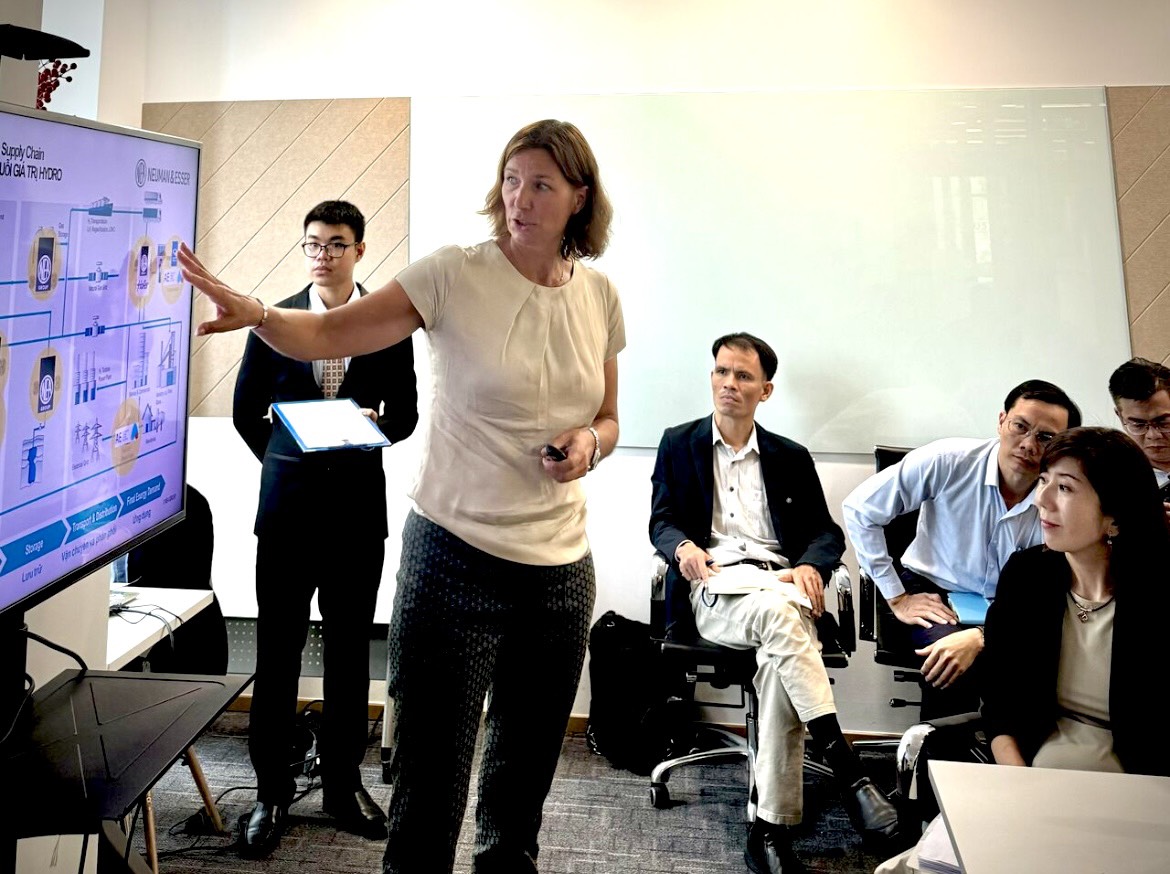
Ms. Stefanie Peters, a member of German National Hydrogen Council
In particular, the Neuman & Esser Group led by Ms. Stefanie is aiming at 2 industrial criteria including developing high-efficiency electrolyzers and developing synchronous infrastructure.
Concluding her presentation, Ms. Stefanie stated: We need to develop prerequisites and measures to enable projects to move more quickly from the planning phase to the operational phase. The hydrogen value chain is complex because of the strong interactions between its elements. The H2 economy starts with the realization of subsystems and their interconnections. To ensure that projects do not fail due to the neglect of interactions between elements in the hydrogen value chain, we apply an integrated approach. It is enough to start with the realization of the elements of the H2 Economy and be open to partnerships – H2 is not a one-party program but requires the cooperation of many.
The next presentation was by Dr. Ngo Hao, strategy director of the Neuman & Esser Group on integrated hydrogen fueling stations. According to Neuman's calculations, the cost of using hydrogen and diesel trucks is expected to be equal by around 2030. In terms of investment efficiency, Dr. Hao said that a medium-sized hydrogen station needs to sell 275 kg/day to break even. The presentation also detailed the Integrated Solution Design for a hydrogen station from clean power sources to the end user, which is the hydrogen-powered vehicle.
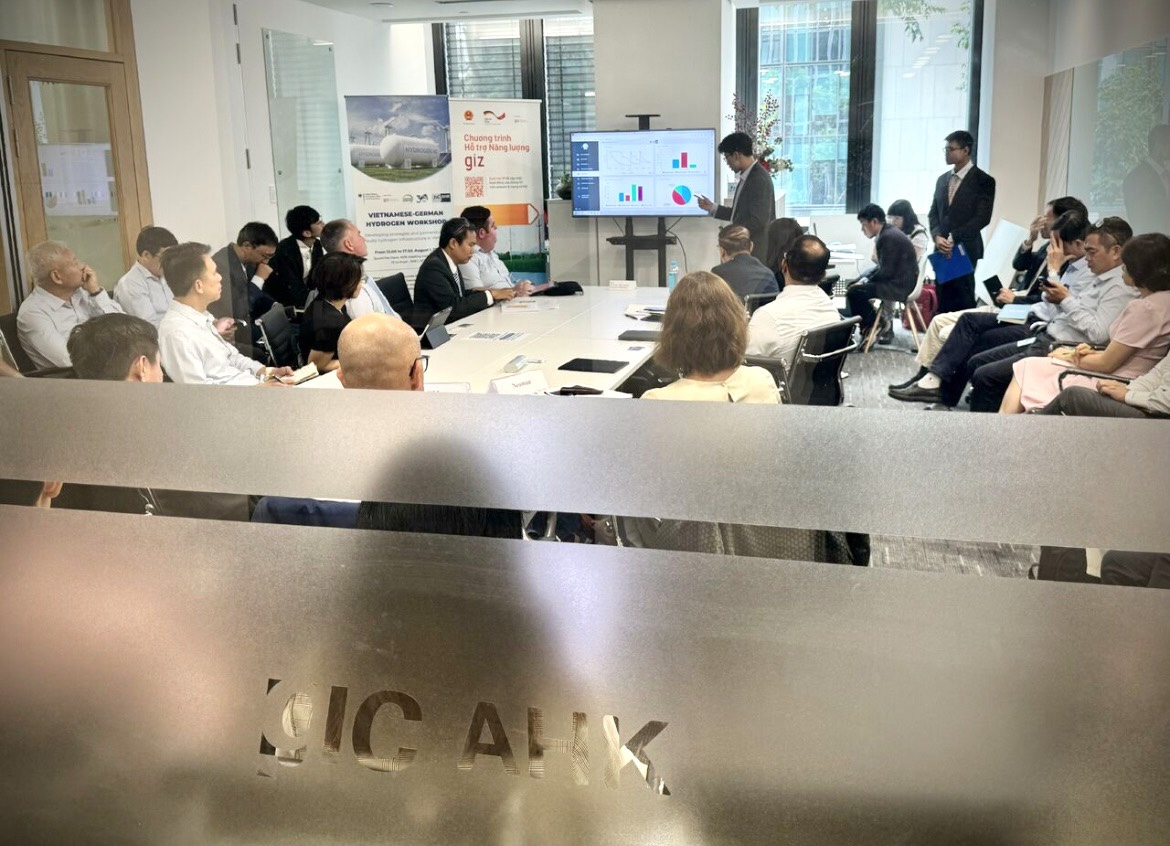
Dr. Hao Ngo from Neuman & Esser
Dr. Thomas Nguyen, Deputy General Director of VATEC Consulting Company, introduced the Vietnam hydrogen strategy 2030, with a vision to 2050, Vietnam will produce up to 30 million tons of green hydrogen/year and highlighted the strengths of Vietnam's renewable energy resources. Dr. Thomas made recommendations on:
ESTABLISHING PORT INFRASTRUCTURE FOR HYDROGEN EXPORT
A CLEAR ROADMAP FOR EXISTING AND NEW COAL AND NLG PLANTS
INCREATIONS FOR OFF-GRID REGENERATIVES FOR HYDROGEN PRODUCTION
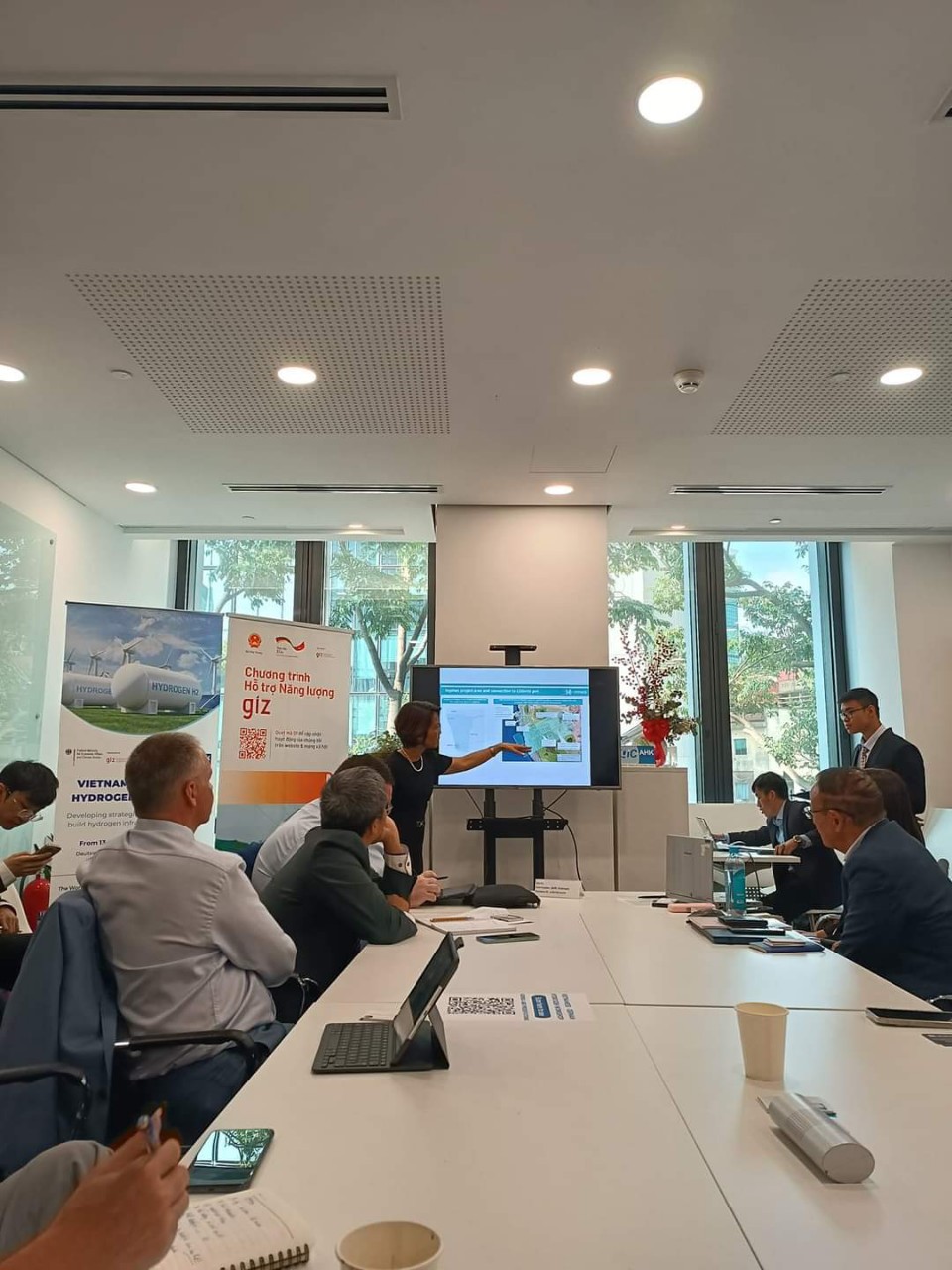
Ms. Vu Thi Duong, Enertrag country director, presented a paper.
Ms. Vu Thi Duong, Enertrag Country Director, introduced the Combined Hydropower and Power Plant (CH2P) Solution. Within a radius of 20-30km, wind and solar capacity are installed and generate the main electricity. The ENERTRAG collection grid collects and converts the electricity and can put additional infrastructure in place for different energy sources, such as hydrogen and heat. By providing a hybrid grid connection for generally uncorrelated wind and solar generators, a 1.5 GW grid connection to the TSO could remove primary power from approximately 3-4 GW of installed wind/solar capacity. Adding battery storage could boost grid connection utilization, allowing for more renewable deployment and smoothing supply. Adding an electrolyzer would allow for additional installed renewable capacity while maintaining grid connection and increasing utilization to >6,000 full load hours. Hydrogen re-electrification would further stabilize energy supply, for example during events such as the extended “Dunkelflaute” festival. With the development of the Hybrid Power & Hydrogen Plant, ENERTRAG is working to implement the energy transition across all sectors in a system-supporting manner, ~6-7 GW or renewable energy requiring only ~1.5 GW of grid capacity. This setup allows for the supply of green electricity and H2 on demand - "supply on forecast", as well as heat, for example via PtH or waste heat in processes.
Ms. Duong introduced the Group's large-scale electrohydrogen production project in Nambia, the Hyphen Project: The first step in the industrialization of green hydrogen in Namibia. The project produces clean electricity from wind and solar power, produces green hydrogen from seawater desalination and electrolysis at the complex with a green hydrogen export port. A large-scale complex of 3.5GW solar power 4GW wind power, producing 370 thousand tons of green hydrogen and 2 million tons of green ammonia annually, a valuable reference model for Vietnam.
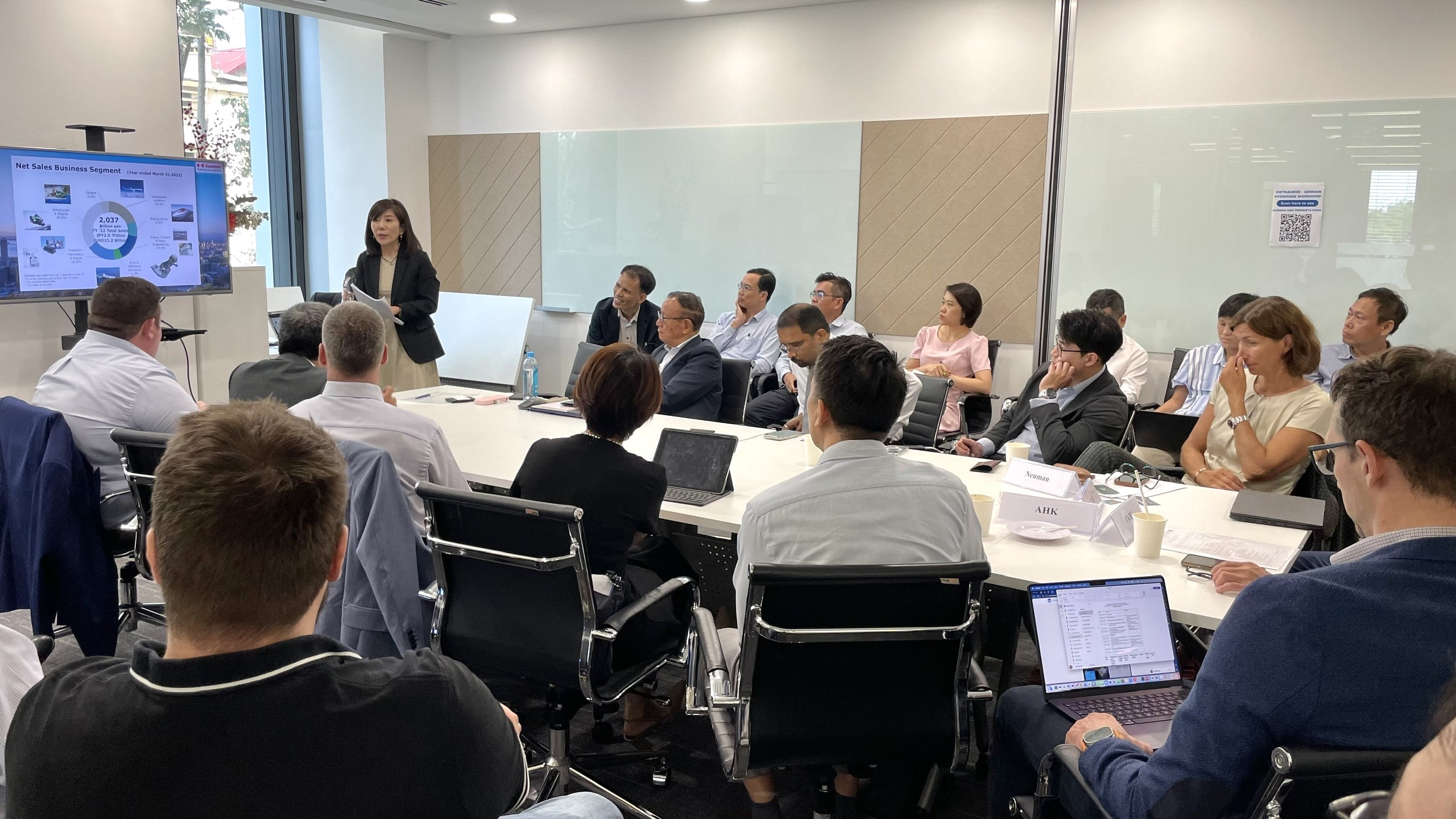
Ms. Miho Nishida, Chief Representative of Kawasaki Vietnam
Ms. Miho Nishida began the introduction of Kawasaki Heavy Industries, established in 1837, as Japan's leading heavy industry group with industries such as shipbuilding, aviation, motorcycles, large engine turbines, high-speed trains and energy with sales of more than 15 billion USD per year. Kawasaki Corporation is the manufacturer of the world's first liquid hydrogen carrier and was honored to welcome Prime Minister Pham Minh Chinh to visit the ship, and the leaders of Ho Chi Minh City to visit the hydrogen facility in Kobe. Kawasaki Corporation has introduced a 'smart hydrogen community' in Kobe city, and recently introduced the first hydrogen-powered motorcycle. Kawasaki is currently cooperating with German electric power group RWE to build a 100% hydrogen turbine in Germany with a capacity of 30MW. In Kobe, Kawasaki introduced the world's first 100% hydrogen Regional Combined Heat and Power Supply (Port Island, Kobe). Previously, Kawasaki designed and installed a natural gas cogeneration system at the world's cleanest paper mill (in My Xuan Industrial Park), cutting CO2 emissions by more than 40%.
Kawasaki has formed a smart hydrogen community, establishing a supply chain from technology, machine manufacturing, hydrogen production to end users.
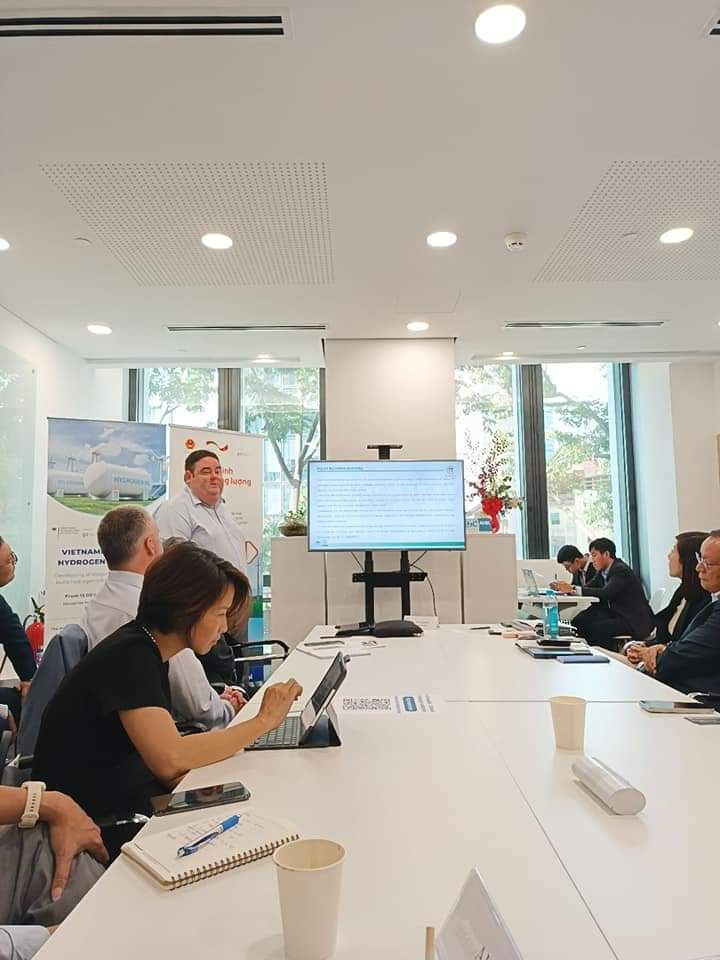
Mr. Steven Coulson, Trung Nam Group presented
Presentation by Mr. Steven Coulson, Deputy General Director of Trung Nam Group, the Group owns a total renewable power capacity of more than 1.6GW from hydropower, solar power to wind power. Mr. Steven introduced the Ninh Thuan green energy complex of Trung Nam Group (TNG). TNG plans to develop a number of Green Energy Zones to produce Green Hydrogen and Green Ammonia in Vietnam for domestic distribution and export. Wind and solar energy are the main sources for the production of Green Hydrogen and Green Ammonia. Green Methanol, Methane and E-fuel will be considered in the future when demand increases. Green electricity will be supplied to the Industrial Park and the National Grid.
TNG is expected to produce 250,000 TPA of Green Hydrogen by 2030, 2.5 million TPA of Green Hydrogen by 2050. Ninh Thuan is a locality with great potential for renewable energy. According to statistics, the whole province has 14 potential wind regions with approximately the same amount of wind blowing all year round, the average wind speed at a height of 6.5 m reaches 9.6 m/s, Ninh Thuan alone has the potential to assess very large wind speed with wind speed >10m/s. Regarding solar energy, the average number of hours of sunshine per year ranges from 2,600 to 2,800 hours. The total average solar thermal radiation output is 5,221 kwh/m2/year, higher than the national average. Grasping the demand for Hydrogen and the renewable energy potential of Ninh Thuan province, Trungnam Group is researching and developing a Green Energy Complex model in Ninh Thuan province.
Component I: Ca Na Green Hydrogen Power Plant;
Component II: Renewable energy complex providing electricity;
Component III: Liquid cargo port complex.
GOAL OF THE COMPLEX:
Self-supply of electricity for Ca Na Green Hydrogen Power Plant;
Produce H2, O2 and
Green NH3 serves domestic and export needs;
Producing products derived from H2 such as H2 fuel cells, fertilizers, green methane (CH4), green methanol (CH3OH) and electronic fuels according to market demand;
Providing green electricity directly to industrial parks (ensuring conditions for granting green energy use certificates to factories);
Using the power transmission system to participate in the national grid stabilization service; Participating in the electricity market when requested by EVN (without PPA) or DPPA; creating a backup inter-regional connection line network for EVN in case of incidents; Participating in production - consumption services, deducting balance with EVN, according to the agreed rate.
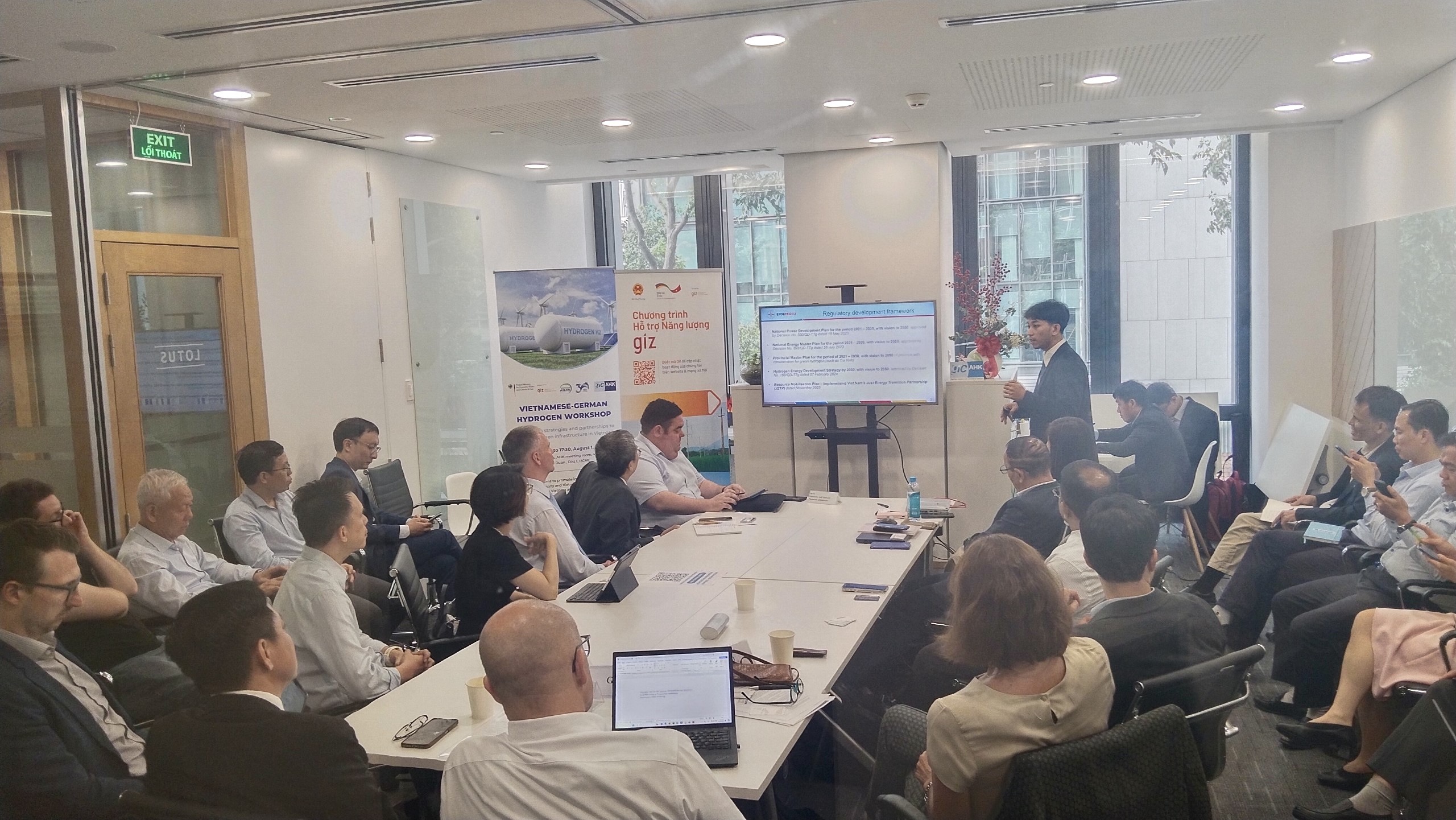
Mr. Nguyen Ngoc Phuc Dang, legal expert of PECC3
Presentation by Mr. Nguyen Ngoc Phuc Dang, legal expert from PECC3 Consulting Company, Mr. Dang summarized the main objectives of the Ministry of Industry and Trade (MOIT) developing a plan for the production, transportation and use of green hydrogen (H2) and its derivatives. This regulation and the following regulations will aim to develop the green hydrogen industry, especially for industrial production (petrochemicals, fertilizers and steel, etc.) and transportation (large-scale transportation, H2 fuel cells for example trucks). Further research is needed on the use of green H2 and ammonia (NH3) in power generation (blended with LNG, coal). Policy actions to be considered: National roadmap for green H2 and its derivatives, including market development. Mr. Dang shared details of the Policy Development under the RMP (JETP): Specific plans and regulations on the production and use of green H2, green NH3 and other synthetic fuels derived from green H2. Regulations on H2 certification standards (What is green H2 and other colors). Regulations on safety in storage, transportation and use of green H2. Policy on cooperation in R&D between public and private sector units, focusing on R&D of technological innovations in … green hydrogen and derivatives; Policies and programs for retraining/training of workers who lose their jobs during the energy transition and for workers to be facilitated to grasp new opportunities brought by … green hydrogen … The legal framework on green hydrogen is still in its infancy. The number of green hydrogen projects implemented in Vietnam is very limited due to the lack of a specific mechanism to encourage development. Incentive mechanisms and policies for green hydrogen solutions are one of the priorities
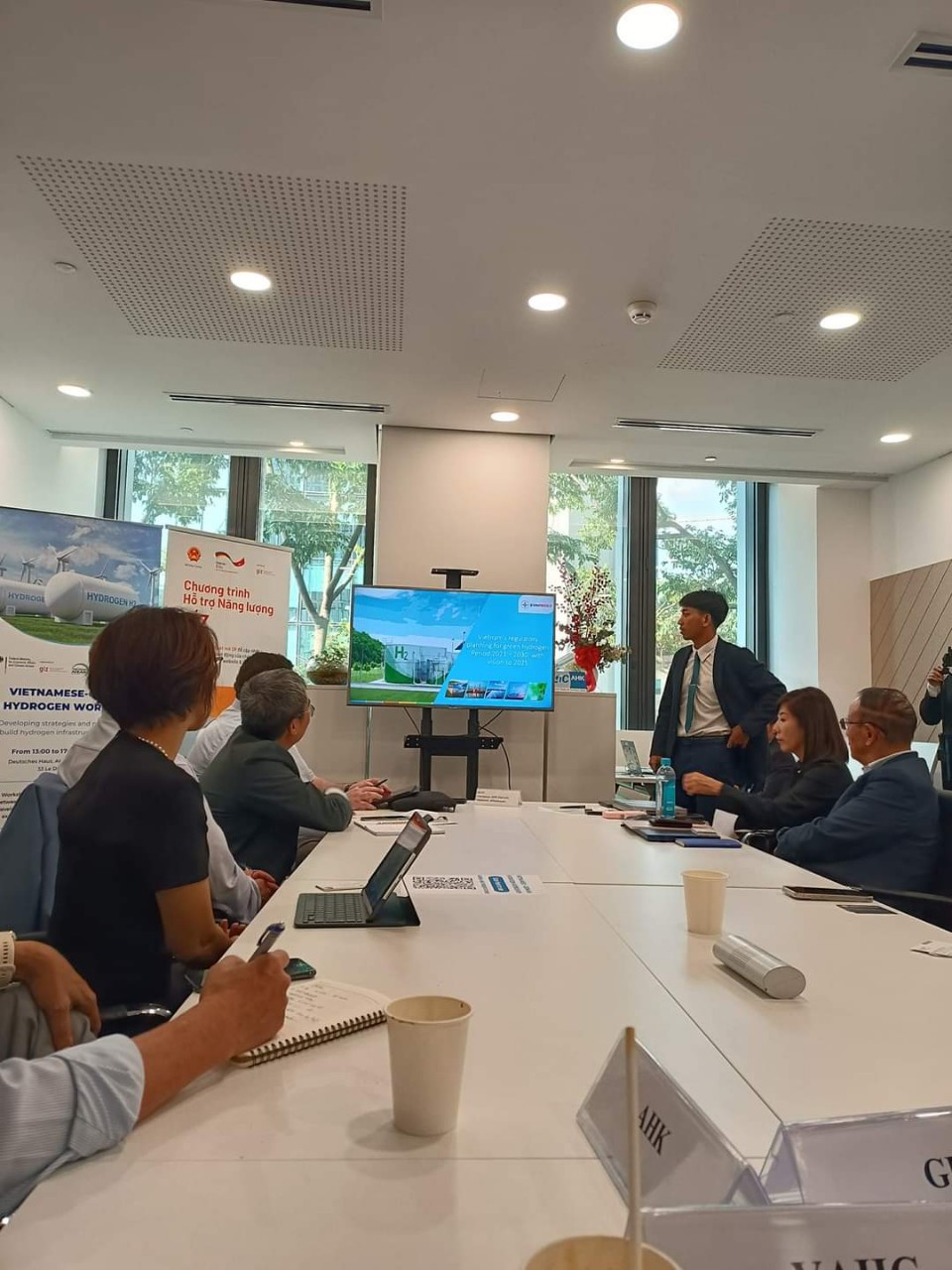
Mr. Nguyen Ngoc Phuc Dang
The discussion then revolves around opportunities from participating in policy consultation, participating in hydrogen infrastructure construction, opportunities for seeking green financial funding and opportunities for domestic and export green hydrogen trading. Mr. Le Ngoc Anh Minh shared his experience in developing infrastructure projects, citing a bus project in Ho Chi Minh City. Bus operation itself may not generate enough revenue to sustain the project, but investors have been flexible in finding additional sources of revenue, such as from wharf exploitation. Mr. Minh said that investors in green hydrogen projects, especially demonstration projects in Vietnam, need to be flexible and creative in finding investment methods to create multiple sources of revenue to sustain the project, not just focusing on pure revenue from hydrogen consumption. For example, for the proposal of a hydrogen demonstration project running hydrogen buses in Ho Chi Minh City, the research team calculated additional revenue sources from selling carbon credits, from exploiting hydrogen filling stations for commercial purposes, from selling additional hydrogen products on buses for tourists to experience, and even opening a hydrogen coffee chain at hydrogen filling stations. Ms. Stefanie said that Neuman & Esser Group is currently focusing on industrial projects using hydrogen and has not yet participated deeply in public hydrogen projects because the negotiation process and the development of preferential policies of the state are generally slow and if calculated in a straight line, the project will not be profitable and cannot borrow capital. That is also the common situation of hydrogen projects in the world: the project is not feasible so it cannot borrow commercial capital. Speakers Thomas Trung and Nguyen Ngoc Phuc Dang shared about the legal infrastructure for implementing hydrogen projects and the most interested question for potential consumers that VAHC often receives: how much does 1kg of clean hydrogen cost in Vietnam? According to Mr. Thomas Nguyen, up to now, the parties have relied on different calculation methods, due to the high influence of technology, so there has not been a price set according to the market. To calculate a price, it requires the buyer, the consultant and the technology side to sit down and work together in great detail. VAHC said that currently, there are FDI manufacturers in the garment and material industry in Vietnam sending requests for clean hydrogen prices, there are large manufacturing corporations setting net zero targets for 2030, 2035 and they have very serious requests for clean hydrogen right in the Vietnamese market. When asked about the opportunity to export hydrogen to Germany, Ms. Stefanie, a member of the German National Hydrogen Council, did not confirm this opportunity. When Mr. Minh shared that the New Energy Organization (NEDO) of the Japanese Government has granted a Japanese corporation a budget of
With a budget of about 7 million USD for a demonstration project in Long An, is it possible that the German Government will fund a demonstration project in Vietnam? Mr. Markus Bissel said that further consultation is needed to give an exact answer. In the opening part of the presentation, Mr. Markus Bissel said that GIZ is currently funding energy innovation projects in Vietnam and effectively supporting MOIT in green energy programs as well as specialized seminars. Regarding the hydrogen field, Mr. Markus said that GIZ has funded the Vietnam-Germany University, which is currently implementing a hydrogen research project in Binh Duong. GIZ has a hydrogen research funding program, and partners can contact and apply for approval according to regulations with funding from 50 thousand USD to 2 million USD. Mr. Ha Hai Thanh, Deputy Head of PV Gas's Technology and Engineering Department, said that PV Gas has a leading gas industry foundation in Vietnam and is currently drafting green hydrogen demonstration projects based on the Group's gas platform. PV Gas wishes to cooperate with international partners to finance its demonstration projects.
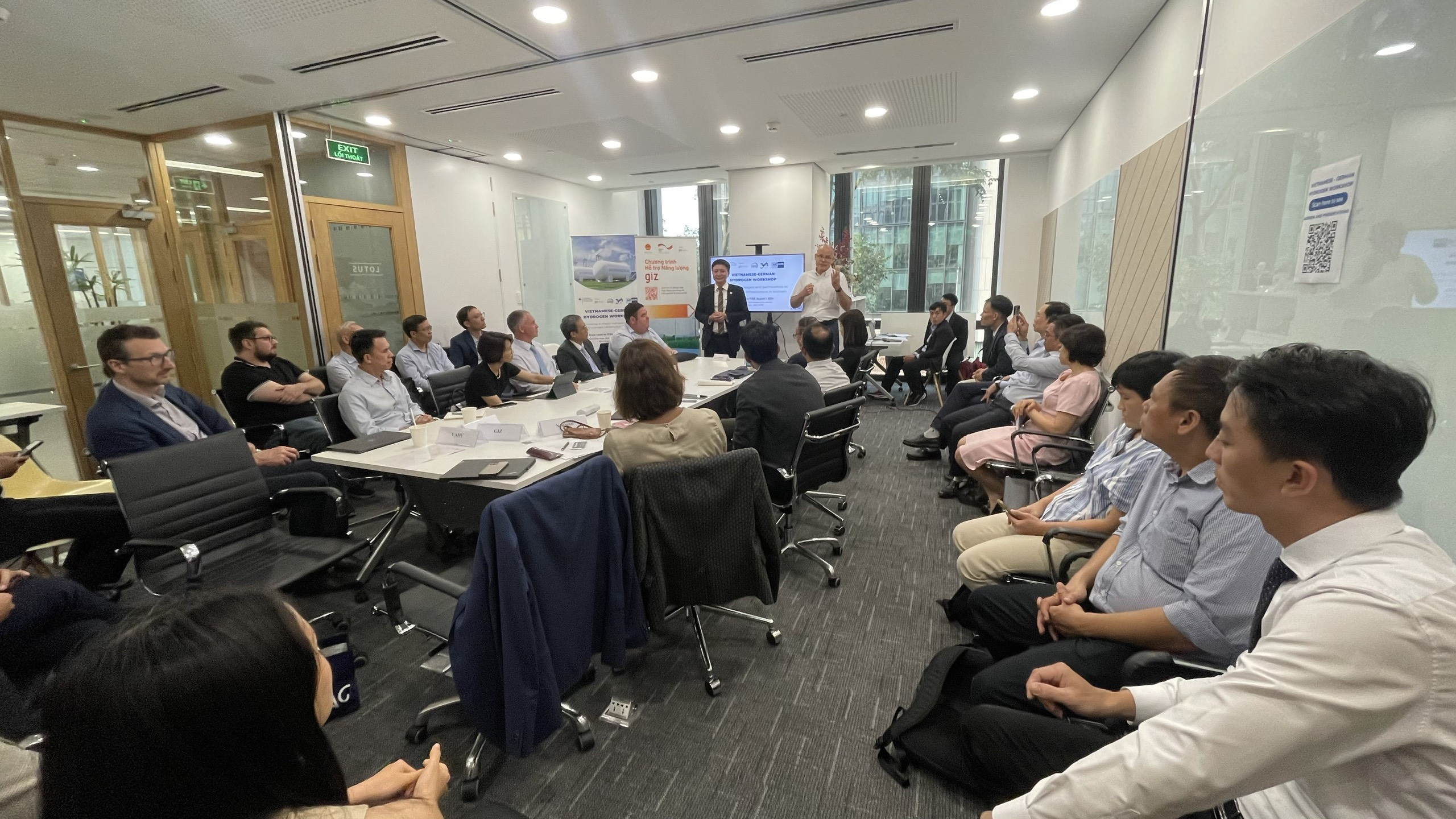
Concluding the workshop, Mr. Le Ngoc Anh Minh, Chairman of VAHC, reiterated the opinion of a representative from Neuman on establishing a joint working group to implement a hydrogen demonstration project as soon as possible. Mr. Markus Bissel, representative of GIZ, expressed his support for this idea and hoped that exchanges on hydrogen would continue in the coming time to form a broad hydrogen community, form hydrogen infrastructure, attract financial investors through feasible plans and promote cooperation between Germany and Vietnam in the fields of technology, green finance, infrastructure development, and green hydrogen supply chain in Vietnam.

Please scan the QR code to get presentation materials from speakers






